Domehenge: Where the wild things are
 Over the past two decades we have watched the ebb and flow of wildlife around our mountain top home. The first was a bear, which we never saw, but which visited our tent while we were back east and left his mark. We found our tent with four long slits in the side. He didn’t enter the tent, but we didn’t sleep very well that night. Thank goodness we had not left any food in or around the tent and grounds.
Over the past two decades we have watched the ebb and flow of wildlife around our mountain top home. The first was a bear, which we never saw, but which visited our tent while we were back east and left his mark. We found our tent with four long slits in the side. He didn’t enter the tent, but we didn’t sleep very well that night. Thank goodness we had not left any food in or around the tent and grounds.
BEAR
Once we started building the house Mister Bear stopped by from time to time. Here he is helping us stack the construction lumber. He even offered to come up from the road and help us. But we discouraged that.
My local workers lived in West Virginia and drove up here at about 7:30 each morning. One morning I heard their truck arrive but no one came in. Then they started to blow the truck horn. I flung open the front door and there was Mr. Bear, standing in the carport, just 10 feet away. He seemed to be saying “Go away, this is my house” to the truck full of workers.
MOUSE
 One night I was sitting alone in the small dome, the boys having all gone to Oakland for dinner, when suddenly I saw a motion on the table. Then, in the candlelight, I saw a Saltine cracker stand up on one corner and proceed to march across the table. It stopped moving when I turned my head and then it ran down the leg of the table. At last I could see the four tiny legs and the stout little body that propelled my Saltine out the open door. Here is another picture of mousey coming out of my wastebasket.
One night I was sitting alone in the small dome, the boys having all gone to Oakland for dinner, when suddenly I saw a motion on the table. Then, in the candlelight, I saw a Saltine cracker stand up on one corner and proceed to march across the table. It stopped moving when I turned my head and then it ran down the leg of the table. At last I could see the four tiny legs and the stout little body that propelled my Saltine out the open door. Here is another picture of mousey coming out of my wastebasket.
RACCOON

 The raccoon family sleeps during the day and searches for food in the evening. For years we saw their footprints on the carport and second floor deck. His favorite trick was to climb up the dome struts to the second floor deck and then up to the beam from which the hummingbird feeder was suspended. The raccoons would tip the feeder until all the sugar water poured out onto the deck and then they would go down and lap it all up. We finally had to remove the feeder. Years later we got an automatic wildlife camera and got a picture of the raccoon on the lower deck.
The raccoon family sleeps during the day and searches for food in the evening. For years we saw their footprints on the carport and second floor deck. His favorite trick was to climb up the dome struts to the second floor deck and then up to the beam from which the hummingbird feeder was suspended. The raccoons would tip the feeder until all the sugar water poured out onto the deck and then they would go down and lap it all up. We finally had to remove the feeder. Years later we got an automatic wildlife camera and got a picture of the raccoon on the lower deck.
RABBIT
On and off during the years a rabbit family has wintered over under the guest bedroom deck. We do not see much of Brer Rabbit, but do find his track in the first snow every year.
BLACK SNAKE

 The blacksnake showed up about ten years ago in the small dome, which at that time we were using as a storage facility. I trudged down through the snow and there, warming himself in the sunlit window was this long, black snake. Well, I had to get what I had come for so I carefully opened the door and got my loot. I turned to leave and “Hello!” There, curled around the door frame, bigger and fatter, was his mate watching my every move from about a foot over my head. They lived in the small dome for a couple of years and we would often see two snakes all scrunched up together on the window sill.
The blacksnake showed up about ten years ago in the small dome, which at that time we were using as a storage facility. I trudged down through the snow and there, warming himself in the sunlit window was this long, black snake. Well, I had to get what I had come for so I carefully opened the door and got my loot. I turned to leave and “Hello!” There, curled around the door frame, bigger and fatter, was his mate watching my every move from about a foot over my head. They lived in the small dome for a couple of years and we would often see two snakes all scrunched up together on the window sill.
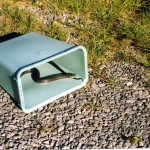
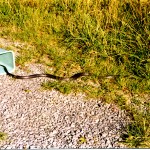 But that was not the first encounter with the black snake family. For a while, when the house was partially finished , Denise and I were living in Crystal City and I was coming out here for the weekends. The second floor was wide open to the elements and there were no stairs and one needed a ladder to go upstairs. One cold spring morning I climbed the stairs and there, sunning himself under the huge, pentagon window was Slinkey, or his girl friend.
But that was not the first encounter with the black snake family. For a while, when the house was partially finished , Denise and I were living in Crystal City and I was coming out here for the weekends. The second floor was wide open to the elements and there were no stairs and one needed a ladder to go upstairs. One cold spring morning I climbed the stairs and there, sunning himself under the huge, pentagon window was Slinkey, or his girl friend.
 What to do? I found a plastic waste can and quickly clapped it over the snake. Now I had a snake under a can! What to do? From the crawl space I found a steel panel (later to become my radio transmitter panel) and slid that under the snake and turned the lot over. Now I had a fat, 6 foot snake in a can which I struggled to take outside. I tipped the can over and out came Slinkey, heading for the deep grass.
What to do? I found a plastic waste can and quickly clapped it over the snake. Now I had a snake under a can! What to do? From the crawl space I found a steel panel (later to become my radio transmitter panel) and slid that under the snake and turned the lot over. Now I had a fat, 6 foot snake in a can which I struggled to take outside. I tipped the can over and out came Slinkey, heading for the deep grass.
And here is a picture taken the next year of Slinkey warming himself on the warm electric generator by the front door.
RUFFED GROUSE
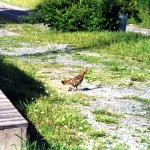
 Here is our Ruffed Grouse that decided to use our Guest Bedroom Deck as a dance platform. Every day for a week or so he would strut and preen on the deck or on the driveway in front of it. Then one day he failed to show up and we guess he succeeded in attracting a suitable mate and they are living happily ever after.
Here is our Ruffed Grouse that decided to use our Guest Bedroom Deck as a dance platform. Every day for a week or so he would strut and preen on the deck or on the driveway in front of it. Then one day he failed to show up and we guess he succeeded in attracting a suitable mate and they are living happily ever after.
 On a sad note, one winter day a Ruffed Grouse smacked into our living room window . This is not uncommon. Once or twice a year a bird will try and fly through a window of our house. One day I was called to investigate a report that a burglar had broken into my neighbors house. He was back east. I found that, as reported, the main living room window was smashed. Glass was scattered all over the deck and grounds. But upon closer examination I saw that it was a double glass window and that the inner pane was not even scratched. Searching the grounds I only found a wing here and a leg there, feathers everywhere, the rest of the bird having been lunch for my local wildlife.
On a sad note, one winter day a Ruffed Grouse smacked into our living room window . This is not uncommon. Once or twice a year a bird will try and fly through a window of our house. One day I was called to investigate a report that a burglar had broken into my neighbors house. He was back east. I found that, as reported, the main living room window was smashed. Glass was scattered all over the deck and grounds. But upon closer examination I saw that it was a double glass window and that the inner pane was not even scratched. Searching the grounds I only found a wing here and a leg there, feathers everywhere, the rest of the bird having been lunch for my local wildlife.
 BOBCAT
BOBCAT
We were sitting on the upstairs deck one day when a big bobcat came sauntering around the side of the building and strolled in front of us. At one point he looked up directly at us and then, without breaking step, continued his stroll across the parking lot and down the hill to the small dome. Some days later we had a camera ready and got this one picture through the window. Unfortunately, the flash went off and the glare on the window almost wipes out the picture.
RED FOX
The red fox is absolutely the most beautiful of all wild animals. A family of red foxes visited us for about a year. One came right in to our picnic area during the July 4th celebration. We shooed him away but he was back the next day. For the rest of that summer a fox or two would show up at evening time every day. At times there were as many as four foxes on the grounds between the deck and the small dome. Sometimes we would toss down slices of baloney which they relished. But as summer turned to fall we stopped feeding them and encouraged them to search for their own food.
SALAMANDER
 This little guy is possibly the Salamander called the Jefferson Salamander in my guide book. But there are a dozen or more salamanders with similar black bodies and white spots.
This little guy is possibly the Salamander called the Jefferson Salamander in my guide book. But there are a dozen or more salamanders with similar black bodies and white spots.
AMERICAN TOAD
There is no concise difference between frogs and toads. The Tubby on the right is probably a male, which as toads go is much smaller than the female. The mating call is a long musical trill, 20 to 30 seconds.
Eggs are laid in two strings on the bottoms of temporary pools.
WOODCHUCK
We call him “Charles” which is short for woodchuck. Charles lives in a little rocky burrow about 40 yards north of the house. He spends his spring and summer and fall eating that spicy red clover and sleeping. He is very, very fat. In the winter I think he just sleeps. Here is Charles coming out of our driveway drain culvert where he often takes his midday nap
TURKEY
 My first view of wildlife here was of a wild turkey. The developer was taking us by Jeep, up a skinny dirt road leading to our property. Suddenly a huge, wild turkey flew up in front of us. The bird flapped and flapped and slowly picked up speed and altitude but couldn’t leave the road because of all the trees packed tightly on each side. It looked to us, following in the Jeep, like a huge, flying bowling ball! Finally it outflew the Jeep and, still no more than 20 feet in the air, it disappeared around a curve, and into the woods.
My first view of wildlife here was of a wild turkey. The developer was taking us by Jeep, up a skinny dirt road leading to our property. Suddenly a huge, wild turkey flew up in front of us. The bird flapped and flapped and slowly picked up speed and altitude but couldn’t leave the road because of all the trees packed tightly on each side. It looked to us, following in the Jeep, like a huge, flying bowling ball! Finally it outflew the Jeep and, still no more than 20 feet in the air, it disappeared around a curve, and into the woods.
Early in summer we see a string of tiny turkeys, a dozen or more, streaming down the road, following their mother and pecking at the host of insects on the roadside. Later in the summer they would fan out, with two or three mothers and broods, to cover the grassy hill on our property.
One memorable time I watched as three or four deer came down across the grassy slope, nibbling the nice clover just as a dozen young turkeys came up the slope snapping up any thing that hopped, jumped or wiggled in the grass. For 10 minutes turkeys and deer passed through each other.,neither aware of the other, until finally the turkeys disappeared into the forest and the deer continued their march down the road.
DEER
The white tail deer are everywhere. The deer have a sort of sense that the hundreds of acres of our development are free of hunters. They court up here, and mate and winter over and have their fawns in my high grass lawn.
CROW
To the south and east of us are the Mitiki coal mines and this is mostly forested land. On the other side of the ridge, to the north and west, are the Amish and other fields of corn and hay and cattle. Each morning huge flocks of crows rose from the southern forests and struggled to fly over Backbone Ridge to reach the farms and fields for their daily breakfast. Then, at dusk, the reverse flights would cross our ridge as they returned to their nesting trees. I made a wild guess as five to ten thousand birds. This cycle went on for many years. Then suddenly, in 2006, it stopped.
In 2006 the West Nile Virus swept across the US. The huge flocks of crows disappeared. I saw none the next year, nor the year after. Then in 2009 I saw a single crow cross my property. In 2010 many more came and now I regularly see small flocks of the squawking, chattering, garrulous birds struggling to reach the 3300 feet needed to cross over into those lush farm fields. This poses a question. Are these birds resistant to the virus or are they just the few that were never infected?
TURKEY VULTURE
Backbone Ridge is about 38 miles long and runs in a north northeast direction. The prevailing wind is from the west, resulting in a 38 mile long updraft on the west side of the ridge. These large birds are seen almost daily soaring the ridge. They glide, they turn, they circle, they swoop and, on a rare occasion one might reluctantly flap a wing. It is great to watch the parents teaching the youngsters how to soar. Flap, Flap, Flap the youngster struggles to keep aloft, eventually collapsing into a tree top . A thousand feet higher, just a spec in the bright, blue sky, the parent soars effortlessly, calling to her little ones to follow.
OWL
I was sitting on the upstairs deck having lunch one day when a flying white pillow glided silently across my field of view and disappeared into the forest. I never saw the owl again but we often hear them hooting to each other across the miles of forest within our field of view.
BEAVER

 On the east side of our property is an old logging trail that runs down to the Mettiki Company coal mine. A stream runs down and forms a small lake. Here you will find many trees cut down by beavers and a beaver dam at one end of the lake.
On the east side of our property is an old logging trail that runs down to the Mettiki Company coal mine. A stream runs down and forms a small lake. Here you will find many trees cut down by beavers and a beaver dam at one end of the lake.
BAT
I have not come face to face with a bat, but during our summer cook-outs we are often visited in the evening by a bat attracted to the smell of our cooking hot dogs. If you are lucky you can flip a tiny bit of hot dog up into the air and glimpse a bat swoop down on it. They love flying junk food!
REFERENCES
Ref 1 — “Animal Tracking and Behavior” by Donald and Lilian Stokes
Ref 2 — “Amphibians and Reptiles of the Carolinas and Virginia” by Martof, et al.
Ref 3 — “Eastern Birds” Roger Tory Peterson
Did you enjoy this post? Why not leave a comment below and continue the conversation, or subscribe to my feed and get articles like this delivered automatically to your feed reader.










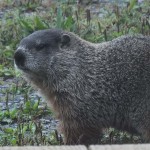






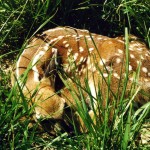


Dad, did you ever get a picture of the “fisher cat”? That thing was cool, too!